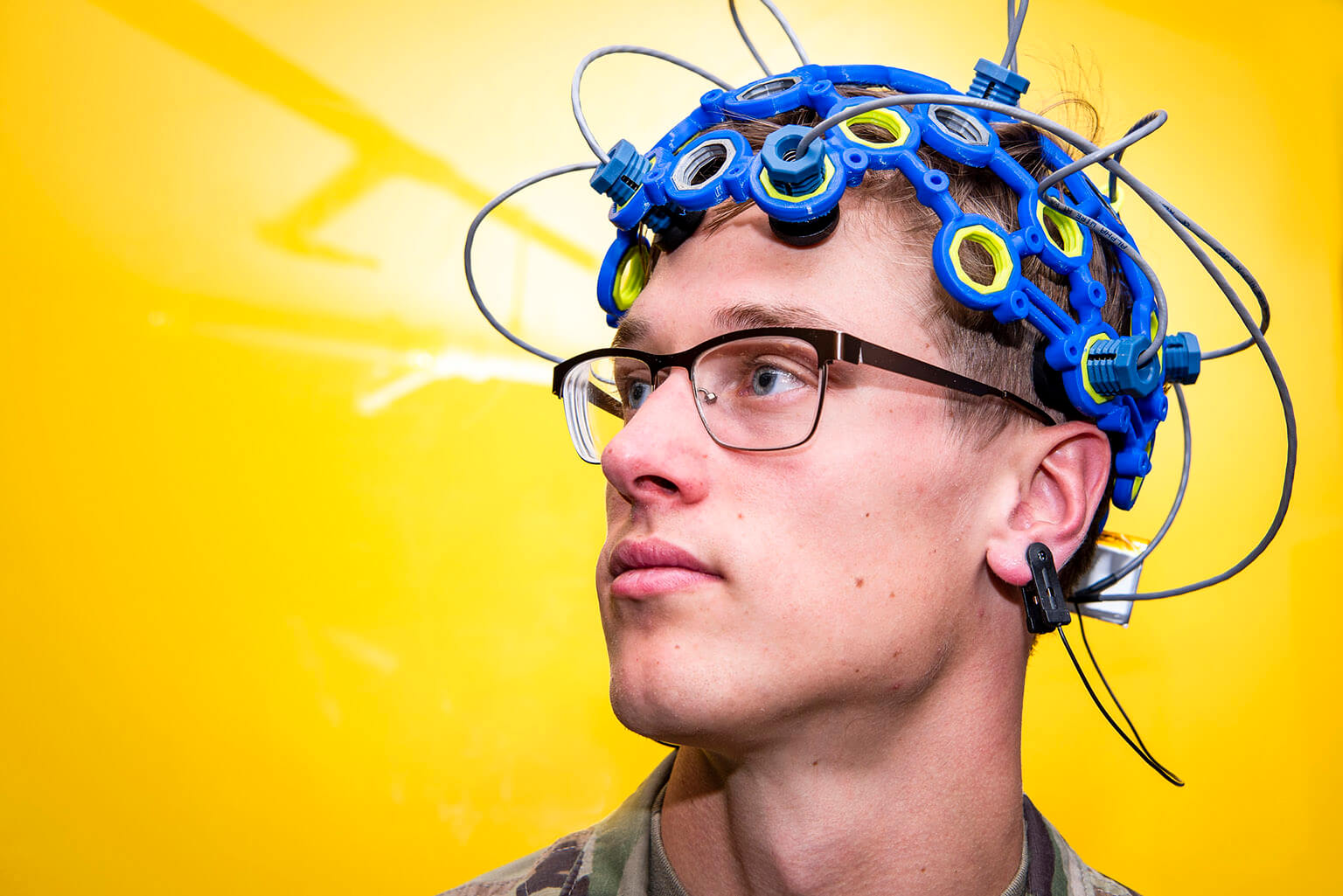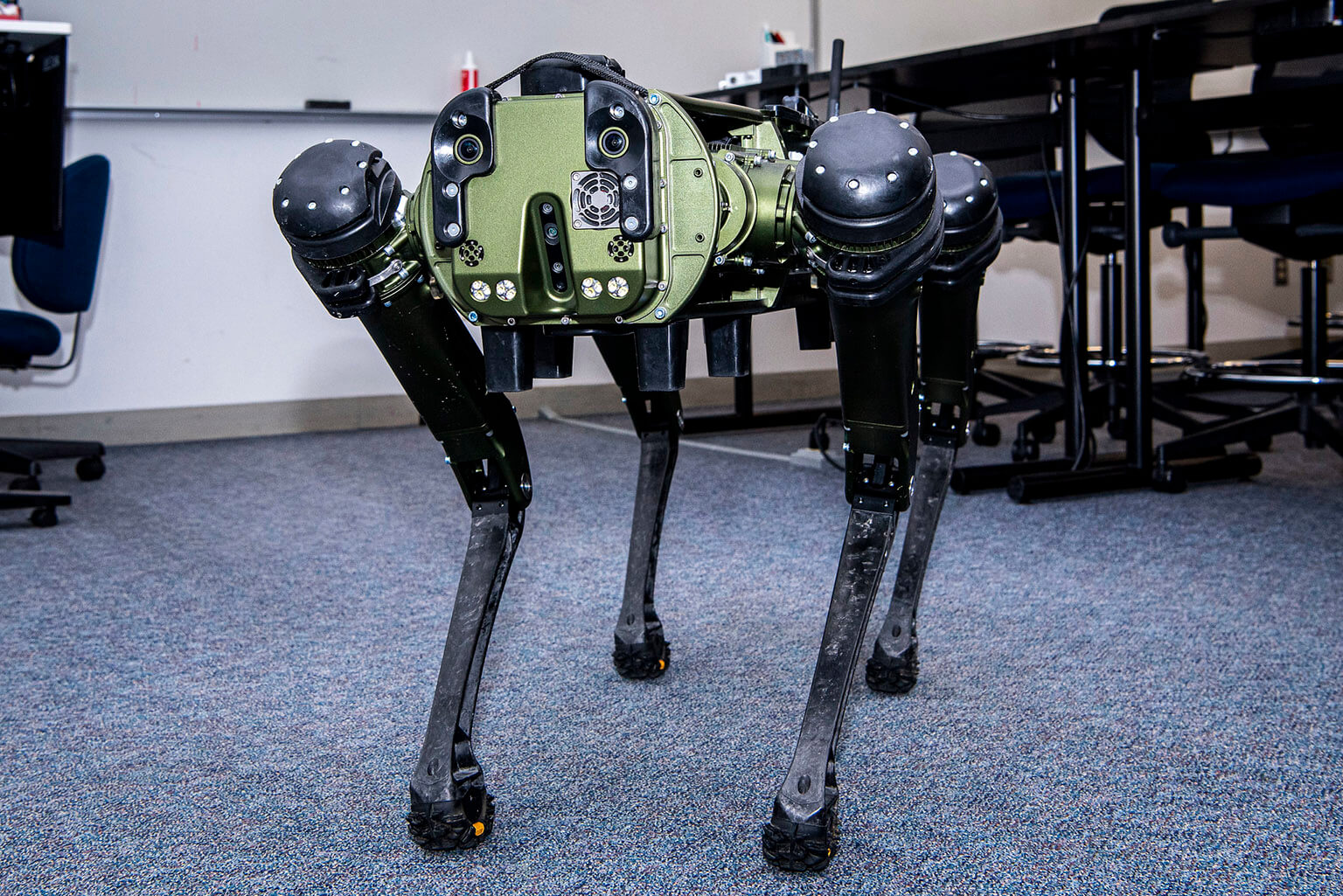Cadet AI research today leads to innovation tomorrow
 Cadet 1st Class Samuel Brennen demonstrates brain-computer interface technology in the U.S. Air Force Academy Department of Computer and Cyber Sciences September 28, 2023. (U.S. Air Force photo by Justin Pacheco)
Cadet 1st Class Samuel Brennen demonstrates brain-computer interface technology in the U.S. Air Force Academy Department of Computer and Cyber Sciences September 28, 2023. (U.S. Air Force photo by Justin Pacheco)
By Randy Roughton
U.S. Air Force Academy Strategic Communications
U.S. AIR FORCE ACADEMY, Colo.- It sounds like something straight out of Hollywood’s latest blockbuster—Airmen controlling drones with their minds.
But rather than being complete science fiction, U.S. Air Force Academy Department of Computer and Cyber Sciences cadets work to make it science fact.
Capstone research in artificial intelligence
Cadet 1st Class Kayleb Klapp is just one of the cadets working on several capstone projects with the goal of harnessing artificial intelligence. In this case, it is “to interpret electroencephalography output to useable output,” Klapp said.
Basically, use the power of thought to control a drone.
Klapp, a member of Cadet Squadron 37 and Computer Science major with an emphasis on artificial intelligence, began his AI work with the Autonomous Systems Integration course. This was followed by a summer research program with the Air Force Research Laboratory in Rome, New York. He hopes to further his AI work in graduate school.
“I wasn’t too sure of what would come from my cadet career when I first arrived, but there has been plenty of opportunity,” Klapp said. “Combined with my capstone [research], these experiences have made me very comfortable working with and building AI.”
 Pictured is the Ghost Robotics Vision 60 robot in the U.S. Air Force Academy Department of Computer and Cyber Sciences September 28, 2023. (U.S. Air Force photo by Justin Pacheco)
Pictured is the Ghost Robotics Vision 60 robot in the U.S. Air Force Academy Department of Computer and Cyber Sciences September 28, 2023. (U.S. Air Force photo by Justin Pacheco)
Shaping future leaders with AI and cyber innovation
The Computer and Cyber Sciences Department’s major areas of AI work involve scalp-based brain-computer interface technology, neural networks, and human-robot interactions, said assistant professor Dr. Chad Mello.
The faculty facilitates cadet skills with “empowered leadership through cyber resilience and artificial intelligence innovation,” Mello said. “We are shaping tomorrow’s leaders in cyber resilience and AI innovation.”
Brain-computer interfaces
Cadets like Klapp work with scalp-based computer interfaces to capture useful brain waves externally through what is referred to as “dry electrodes,” Mello said. The cadets experiment with practical methods to use non-invasive brain-computer interfaces to enable closer integration with humans, robotic tools and technologies.
“We’re nearing a breakthrough where these devices can intuitively discern human intent and respond to new environments in a manner akin to how humans would when encountering them for the first time,” Mello said.
Capstone projects
Capstone projects like the one Klapp is working on are cadet-led with faculty guidance and at the heart of the department’s breakthrough work in AI.
“[Cadets] are helping to actively shape the practical side of AI,” Mello said. “Their work may offer insights and solutions for defense and aerospace challenges. As emerging leaders, Air Force cadets connect today’s AI achievements with future possibilities.”
Capstone projects all have real-world applications and impacts, and the program has evolved to keep pace with the needs and technological advances of the day. This includes an expanded curriculum in modern programming languages and techniques, technology stacks, AI and machine learning, and cyber security.
Additionally, cadets have more interesting capstone research options in engineering topics than ever before, Mello said.
Rapidly transforming AI technologies
“Artificial intelligence technologies are already transforming geopolitical competition and will only increase in its importance over the next few decades,” said Col. Judson Dressler, head of the Cyber and Computer Sciences Department. “Our responsibility at the [Academy] is to ensure the cadets understand its capabilities, how it impacts military strength and deterrence as well as the ethical and legal considerations under the law of armed conflict and the US Constitution. We want them to be prepared for the future character of war, so we maintain our competitive advantage now that the technical transformation is at our doorstep.”
Deep neural networks
Cadets also work on using AI and neural networks. Deep neural networks are indispensable in computer science and almost every other scientific field in “making sense of voluminous data,” Mello said. Scientists use these networks to detect patterns in data that humans cannot see or understand.
“By combining these networks into even larger, more complex networks, we’re able to execute complex tasks in complex environments in ways only dreamed of even 10 years ago,” Mello said.
 Cadet 1st Class Leonardo Camacho applies deep learning to voluminous data for detecting, predicting and classifying astronomical events in the U.S. Air Force Academy Department of Computer and Cyber Sciences September 28, 2023. (U.S. Air Force photo by Justin Pacheco)
Cadet 1st Class Leonardo Camacho applies deep learning to voluminous data for detecting, predicting and classifying astronomical events in the U.S. Air Force Academy Department of Computer and Cyber Sciences September 28, 2023. (U.S. Air Force photo by Justin Pacheco)
See photos of the Department of Computer and Cyber Sciences AI on Flickr.